|
|

 George
H.W. Bush George
H.W. Bush The final disintegration of the Soviet world The final disintegration of the Soviet world China heads off a similar challenge China heads off a similar challenge The Gulf War or "Desert Storm" (1990-1991) The Gulf War or "Desert Storm" (1990-1991)The textual material on this webpage is drawn directly from my work America – The Covenant Nation © 2021, Volume Two, pages 288-300. |

|
|
Vice President George H. W. Bush succeeded Reagan to the presidency in 1989, largely continuing the conservative policies of Reagan. To gain the presidency he had to run against the Democratic Party candidate, Massachusetts Governor Michael Dukakis, but pulled well ahead of Dukakis as the election date approached, winning 53.4 percent of the popular vote to Dukakis' 45.6 percent and 426 Electoral College votes to Dukakis' 111 votes (which, however, did not, interestingly, include Massachusetts). Bush – the making of the man Bush was born in 1924 to easy social privilege, his father, Prescott, being a Yale graduate, a World War One artillery officer and very successful Wall Street investment banker after the war (and eventually in the period 1952-1963, U.S. Senator from Connecticut). Son George thus grew up in wealthy Greenwich Connecticut, attending an elite day school (1929-1937) and then the very prestigious Phillips Academy (1937-1942), where he served as varsity football and soccer captain and senior class president. But at his graduation from Phillips (age 18) Bush enlisted in the U.S. Navy as a naval aviator … and eventually (1944) was sent to serve as a pilot in the Pacific. In an American attack on the Japanese island of Chichijima (September 1944), a number of American planes were shot down, including Bush's. Able to bail out of his downed plane, he alone of the three-man crew survived and was picked up by an American ship. He later learned that other aviators shot down in the mission were captured, executed … and parts of their bodies even eaten by their Japanese captors. This would have a very deep impact on how Bush understood life … causing him to ask the existential question: "why had I been spared … and what did God have for me?" Then just as he was being mobilized for the assault on Japan itself, the Japanese surrendered … and Bush was released from active duty. Just before the war's end he married Barbara Pierce, who he had met earlier while still at Phillips Academy … and would then go on to have six children of their own, among them, his oldest, George W (or just "W"), the first-born in 1946, who would follow in his father's footsteps … right into the White House (2001-1009), and another son, Jeb, who would become Florida governor (1999-2007) and a seeker of the Republican Party presidential candidacy in 2015-2016. In short, a very political family! But the politics part of the Bush family would have to wait a bit as Bush, Sr. attended Yale to study economics and sociology, graduating Phi Beta Kappa in 1948 and having also served as captain of the baseball team … and a member of Yale's Skull and Bones secret society. He then took his family to Texas (in part to get away from the domineering world of his "Up-East" relatives) … where he became an oil field equipment salesman. Eventually he would start up (in partnership with others) his own oil exploration company. But in the meantime (1952) Bush's political world opened up with his decision to actively support Eisenhower's presidential campaign … and his own father's successful run for the U.S. Senate … drawing Bush indirectly into the Washington world. But still, the world of oil would remain his primary focus during the 1950s and the early 1960s. Given his background and business success, Texas Democrats urged him to switch parties and join them … as Democrats dominated both nationally and statewide at the time. But Bush was a very conservative Republican … strongly opposed to the idea of overbearing centralized government. Instead he ran and was elected (1963) Republican Party chairman of Harris county (Houston, Texas). The next year he ran unsuccessfully as the Republican candidate for the U.S. Senate. He would try again in 1966, except this time for a seat in the U.S. House of Representatives … this time unseating the Democrat incumbent … rather substantially. 1966 was a year of huge gains for the Republican Party in Washington, although the Democrats would maintain control of Congress, though by a greatly reduced (though still huge) majority. The Republican Party members of Congress saw in the freshman Bush an avenue to broaden their new appeal through the traditionally "Dixiecrat" (solidly Democrat) South … and appointed him to the highly important Ways and Means Committee. Then two years after that (1968) Bush threw his support to Nixon (rather than Reagan, who was making a presidential run that year) … and was under consideration as Nixon's running mate – though Maryland governor Agnew was finally chosen. In 1970 Bush gave up his seat in the House to run for the Senate … but lost the election. Thus Nixon appointed Bush as American ambassador to the United Nations, Bush's entry into the realm of international politics … during the height of the Vietnam crisis – and also the age of détente. But with Nixon's reelection and Watergate starting up, Nixon asked Bush to chair the Republican National Committee … a major position in the realm of national politics. Then with Nixon's resignation in 1974 and Ford now becoming president, many thought Bush might be asked to be the replacement vice president. But instead Rockefeller was chosen … and Bush was asked instead to head up the U.S. Liaison Office in China (something like ambassador to China, although the new relationship was purposely kept below the status of full diplomatic exchange). And here too (1974-1975), Bush's understanding of international diplomacy headed further down the Realist road … as Bush understood the need for strong – but not bullying – diplomacy … the firm but not domineering use of power. Then to help restore the deeply-declined image of the CIA (closely associated with covert operations that had come to very bad repute) Bush was brought back to D.C. to take charge of the Agency. But in the year that he served in this capacity, he would find that changing the CIA was not easily done. But in any case, with Carter's election in 1976, Bush would once again find himself out of a job. Thus he returned to the business world of Houston. But he had not forgotten life in D.C. Thus he prepared himself for a 1980 presidential run. Of course he found himself running
against a number of other well-known Republicans seeking the Party's
candidacy, including the front-runner, Reagan. It was a tough contest,
and one by one the other candidates dropped out. Finally, with Reagan
pulling way ahead, so also did Bush back out of the race. However,
despite an earlier exchange of political insults, Reagan chose Bush to be
his running mate … seeing in Bush someone who could pull in the support
of Republican moderates. Bush was surprised to get the invitation … and
then worked hard in his support of Reagan. And thus for the next eight
years would serve loyally and quietly as the nation's vice president.
And thus it was that it was now finally his turn to occupy the White
House as the country's president.
|
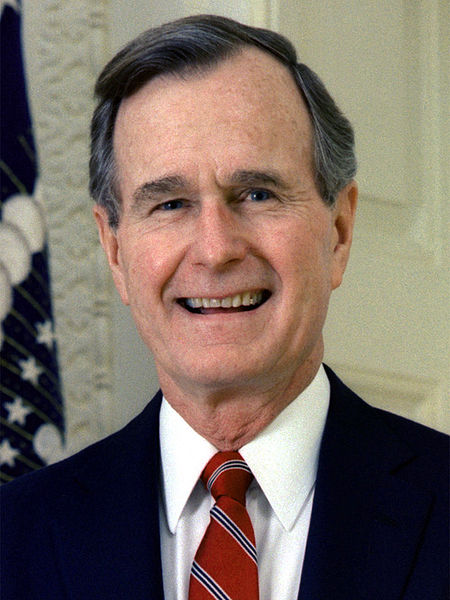
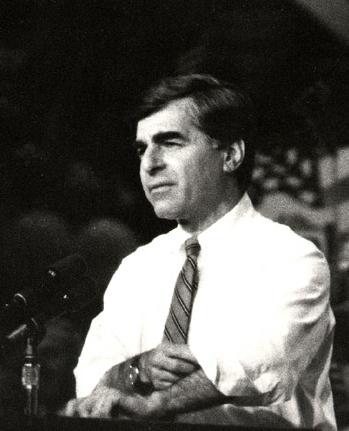
The 1988 presidential
candidates:
George H.W. Bush (Republican) and Michael Dukakis (Democrat)

George Bush and Dan Quayle
nominated by the Republican Party Convention – 1988
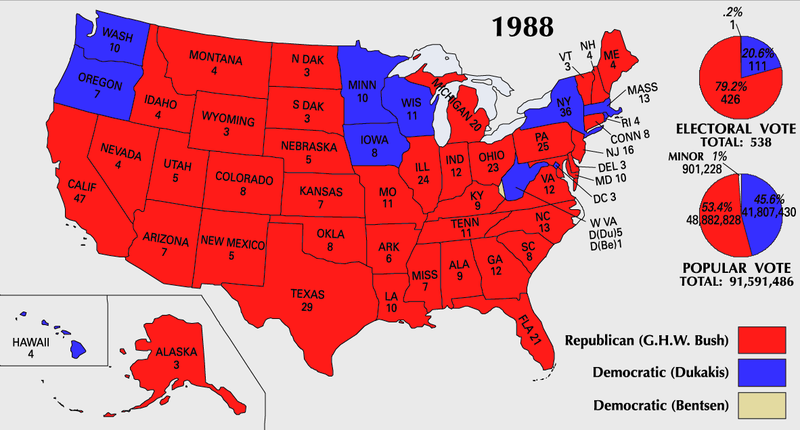
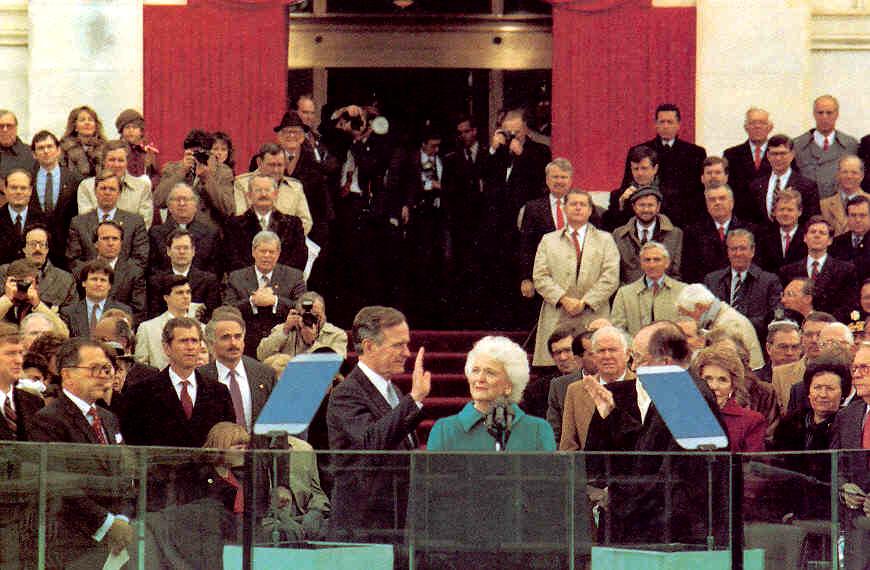
George Bush sworn in as the
41st president of the United States
The downing of the Pan Am jet over Lockerbie Scotland – December 1988
|
Perhaps as the result of an effort by Libyan dictator Gaddafi to see what the newly elected American President was made of (would he be tough like Reagan?), at the end of 1988 a Pan Am passenger jet (Flight 103) exploded in the sky over Lockerbie, Scotland, with everyone on board and 11 people on the ground killed. Under the subsequent investigation of the explosion, the trail eventually led back to Libya. Two Libyans were indicted for murder, although it was not until over 10 years after the event that Libya, at that point seeking better relations with America and the West, handed over the two for trial. But also, Pan Am was sued for failing to take adequate security precautions. But Pan Am defended itself in pointing out that it received hundreds of notices daily about security concerns and had no way to check out each and every one of them. Nonetheless the lawsuit went strongly against Pan Am … bringing the company to bankruptcy and extinction.
|
The remains of Pan Am flight
103 bombed by (Libyan) terrorists over Lockerbie, Scotland
December 21,
1988

|
|
The break up of the Soviet Empire in East Europe (1989).
Although President Bush had little to do with what was about to break out in the Soviet Empire, events there would form a huge part of America's political focus during the Bush years (January 1989 to January 1993). By 1989, the personal freedom and the reshaping of the Soviet government (including a newly elected parliament which had allowed different political parties to compete) that Gorbachev had allowed the Soviet people was transforming not only the Soviet Union but also the whole Soviet Empire in Eastern Europe. Actually, Poland had been edging away from Soviet domination since the creation in 1980 of the Polish workers' movement known as "Solidarity." Solidarity had been largely suppressed by the Polish military, fearful that Solidarity would bring on a punitive Russian reaction if left unchecked. But with Gorbachev's liberalization of the Soviet Union, Solidarity had been allowed to compete openly in Poland, with the result that in elections in the summer of 1989 Solidarity swept the elections and in September formed the first non-Communist government inside the Soviet bloc. This was the beginning of a mad dash by the rest of the Eastern European members of the Soviet bloc to also make their escape, one country after another voting non-Communist governments to power. The most dramatic of all the turnovers was in East Germany, where the Communist leadership was subject to a widening protest movement. Germans began fleeing into a now-free Hungary and Czechoslovakia in order to reach Austria or West Germany – and long-sought freedom. East German Communist leader Erich Honecker resigned in mid-October (1989) and the East German government started falling apart. Finally the Berlin wall was opened in early November to those desiring to leave East Germany, and the movement became a flood. Soon German youth took it upon themselves to start bashing away at the Wall. In Romania the Communist government, seeing what was happening elsewhere, put up stiff resistance to the reform movement. Communist dictator Nicolae Ceaușescu ordered his security forces to fire on protesters – which prompted the military to intervene in late December (1989), but on the side of the protesters. Ceaușescu and his family were arrested and immediately tried and executed. This was the only part of the turnover in the Eastern Bloc that had proved truly violent. The disintegration of the Soviet Union itself (1989-1991) This was the signal for the Soviet Union itself to begin to crumble. Gorbachev had hoped that by softening the hand of Communism he might reverse the apathy of his people to the Communist order, and bring them back to its support. But the response he received was instead for the many ethnic minority republics to begin to press for the same freedoms recently received by the people in Eastern Europe. They wanted total national independence. The first to press the issue were the three Baltic states, Estonia, Latvia and Lithuania at various points in 1989. By the beginning of 1990 almost all the other minority republics, most importantly Ukraine, were demanding some form of national independence. The Communist Party itself was at this point no longer in tight control of the situation. The Gorbachev reforms had brought other groups into national politics in the newly created and empowered Soviet Parliament (the Congress of People's Deputies), considerably weakening Gorbachev's and the Communist Party's hold over the political situation. Under Moscow's mayor Boris Yeltsin (who had abandoned his Communist label) even the huge Russian Federation was demanding independence. Gorbachev was rapidly losing control over a crumbling Soviet Union. In August of 1991 angry Communist hardliners inside the Gorbachev cabinet moved to take matters into their own hands and clamp down on the reforms – and Gorbachev himself. For three days the plotters and their supporters secluded themselves in the Russian Parliament building, while opposition to them outside mounted, led by Moscow mayor Yeltsin. The coup finally collapsed and its leaders were arrested. Ultimately the coup succeeded only in stripping the last bit of authority away from Gorbachev – and moving Yeltsin as the voice of the new Russia into front and center position. Before the year 1991 was out, all of the former Republics making up the Soviet Union, including even Russia, had declared their independence. The Soviet Union was dead.
|
Polish Round Table Talks
took place in Warsaw, Poland from February 6 to April 4, 1989
beginning the challenge
of the East European "Soviet satellite" countries to Communist domination
Germany
Celebrating the collapse
of East German Communism atop the Berlin Wall – November 10, 1989
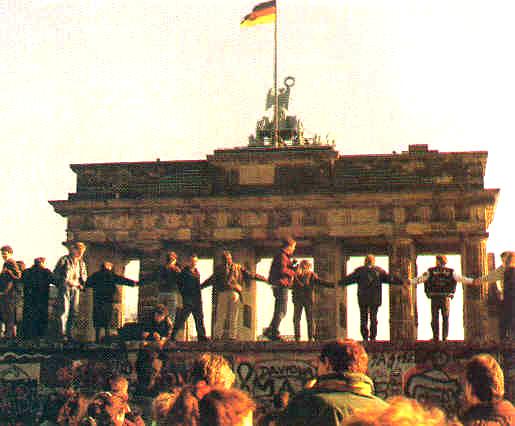
Germans dancing atop the
Berlin Wall
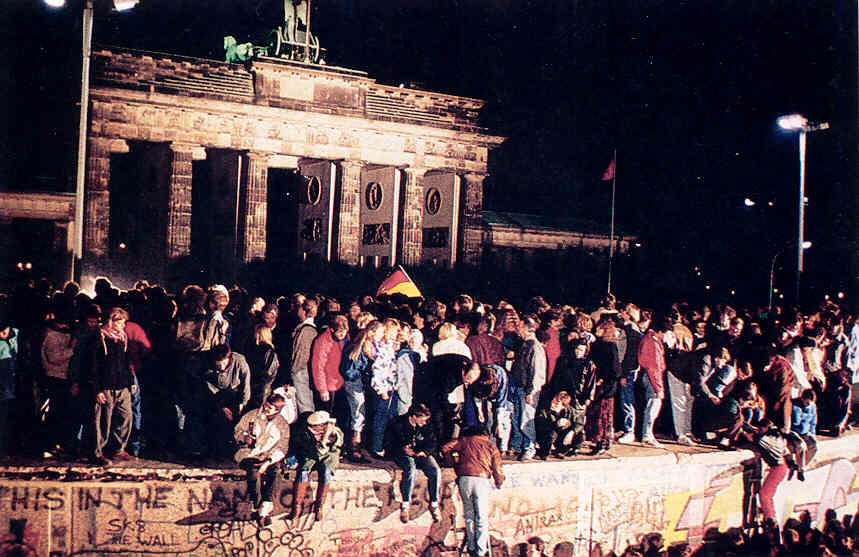
East and West Berliners celebrating
the end of 28 years of separation by the Berlin Wall
November 10, 1989.
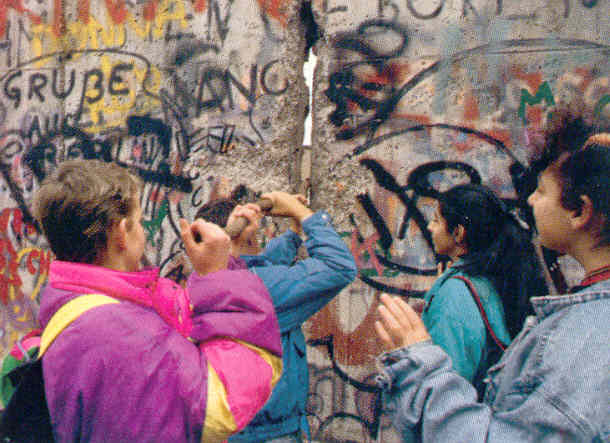
Hammering down the Berlin
Wall
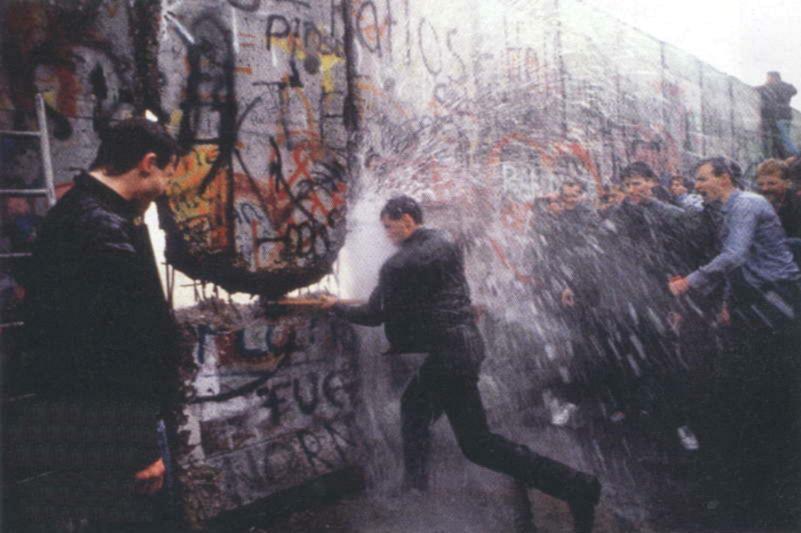
Bashing the Berlin Wall -
1989

Picking apart the Berlin
wall
Germans chipping away at the Berlin Wall
Vaclav Havel & peaceful Prague protest – November 1989
Wenceslas Square during the
Velvet Revolution – November 1989
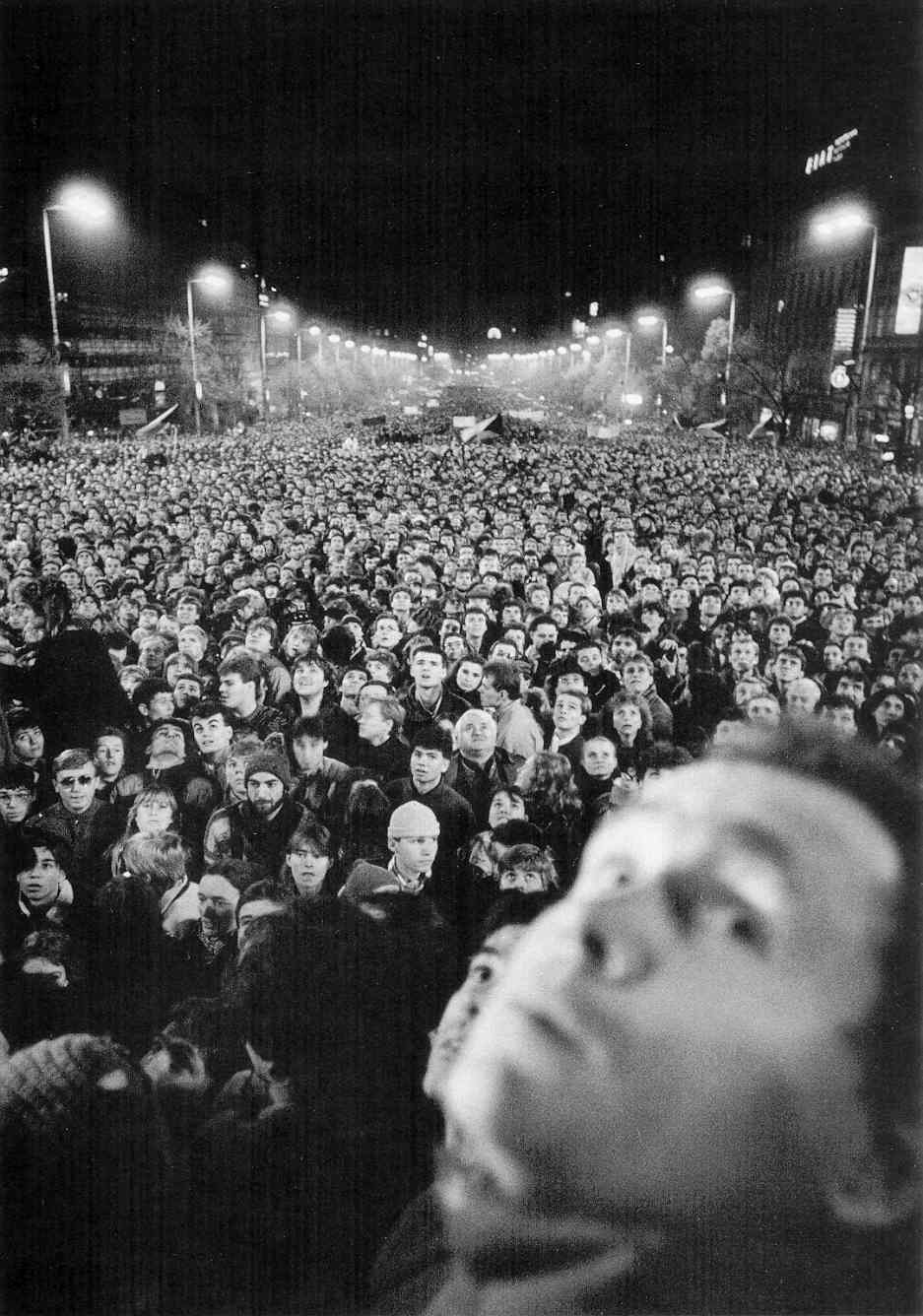
A pro-reform rally in Wenceslas
Square in Prague – November 1989.
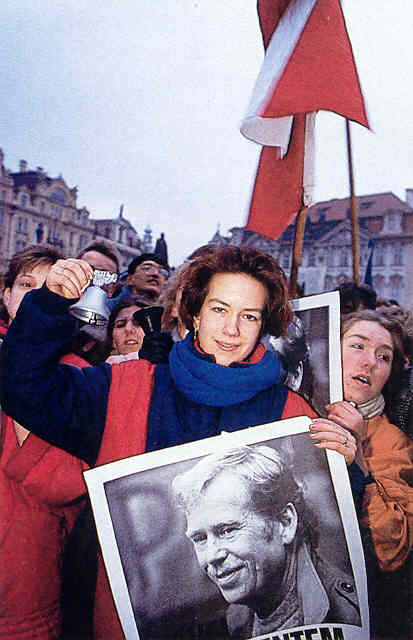
Czechs in Prague celebrating
their new freedoms
... won under the leadership of Vaclav
Havel -
January 1990
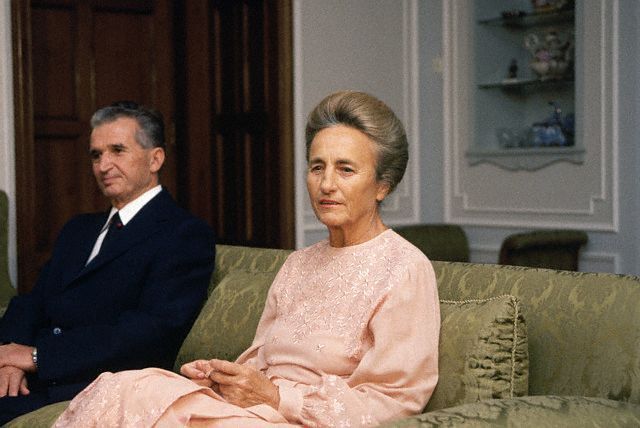
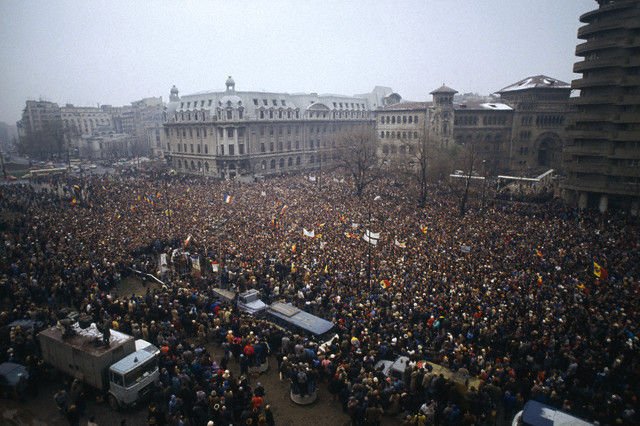
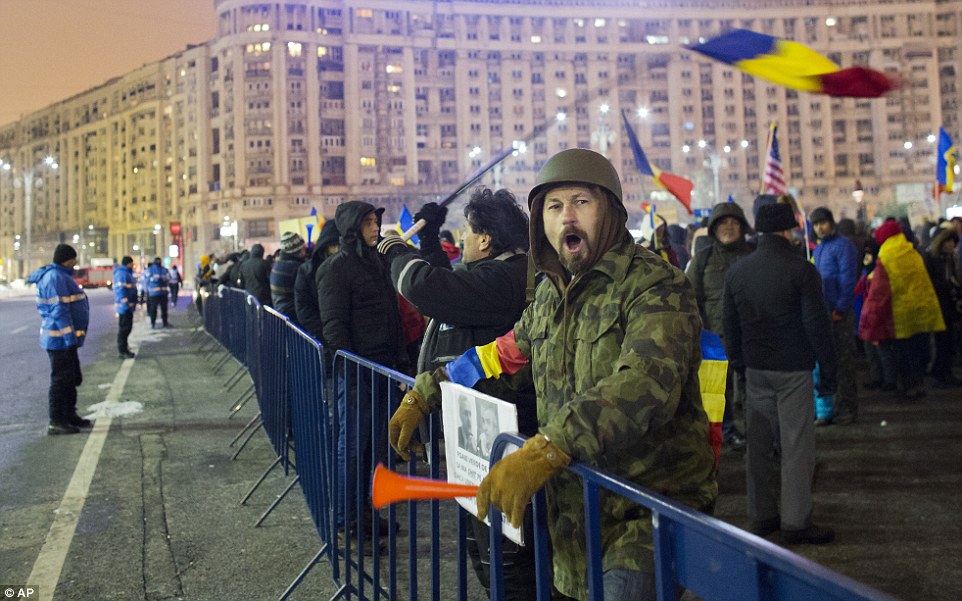
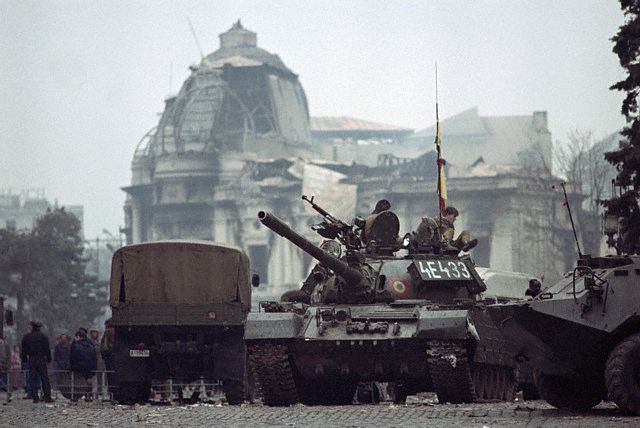
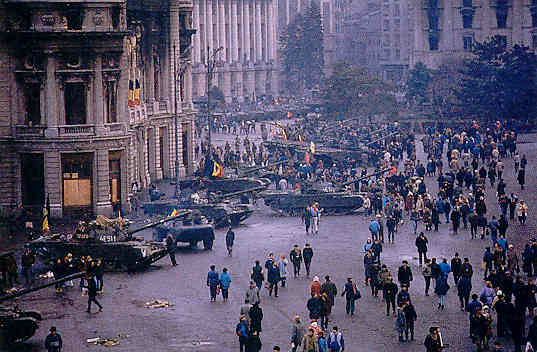
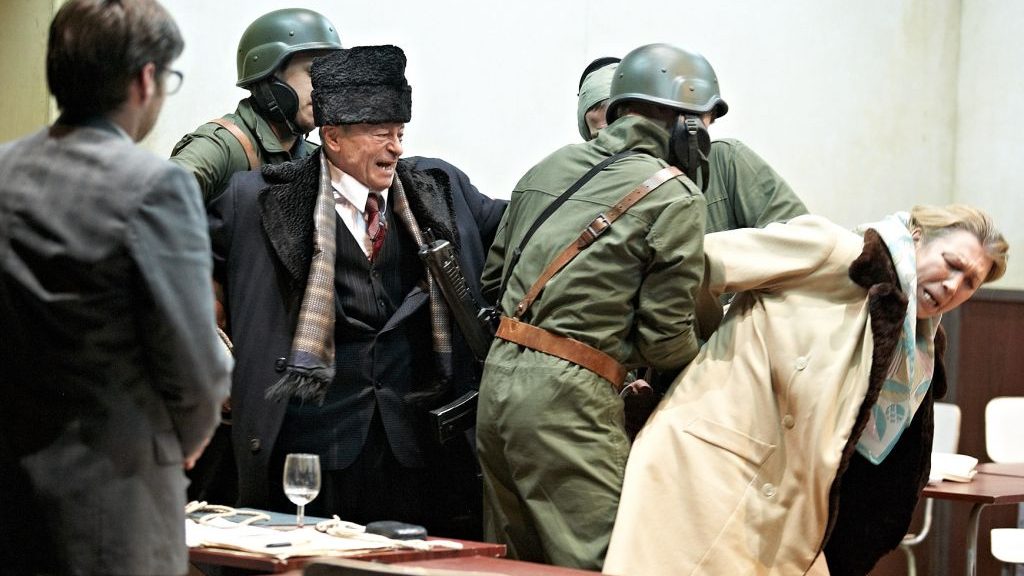
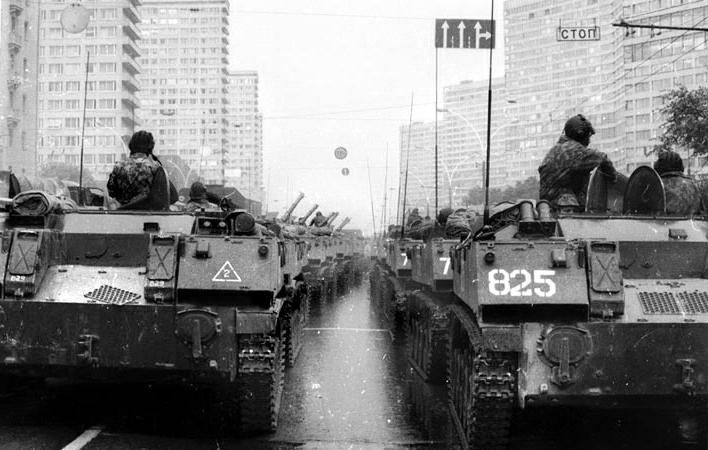
Tanks on Kalininsky Prospekt
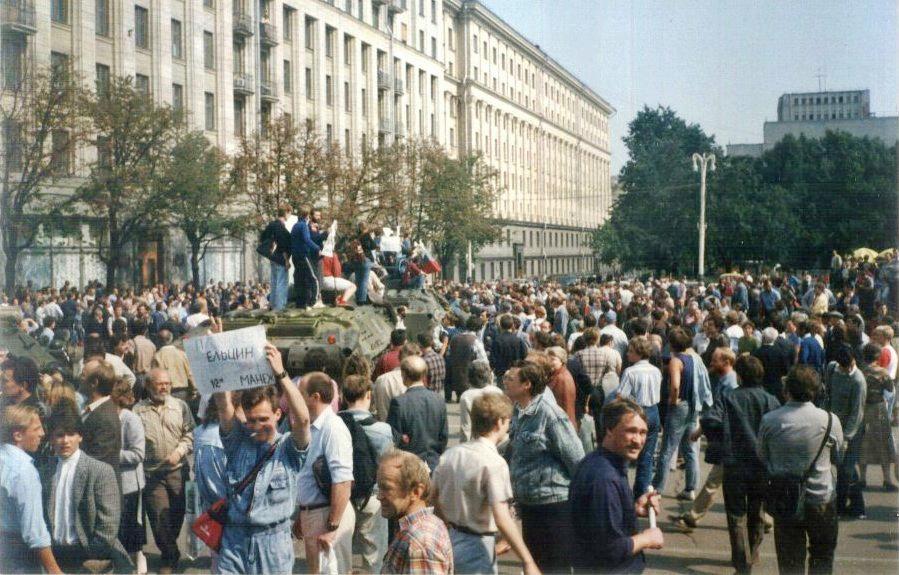
Demonstration in the
streets of Moscow during the August 1991 coup d'etat attempt.
A BTR-70 personnel carrier
is surrounded by the demonstrators.
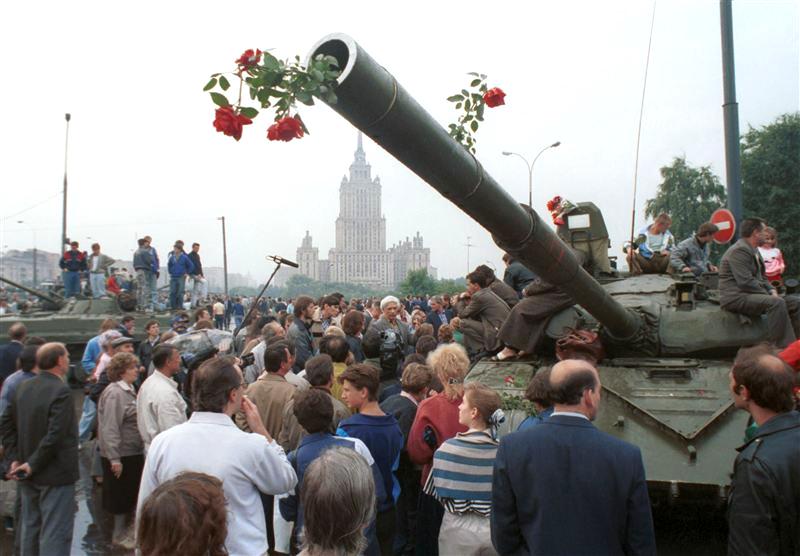
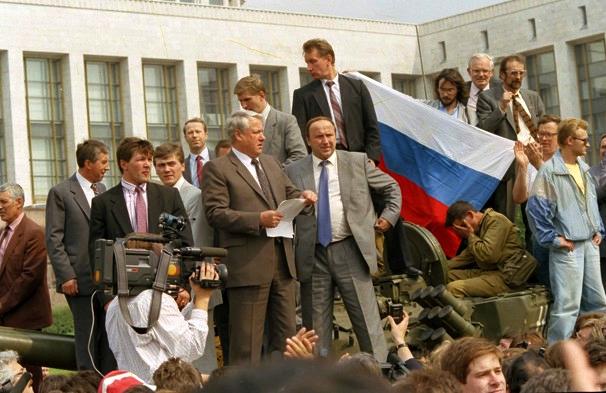
Boris Yeltsin on a tank addressing fellow Moscovites
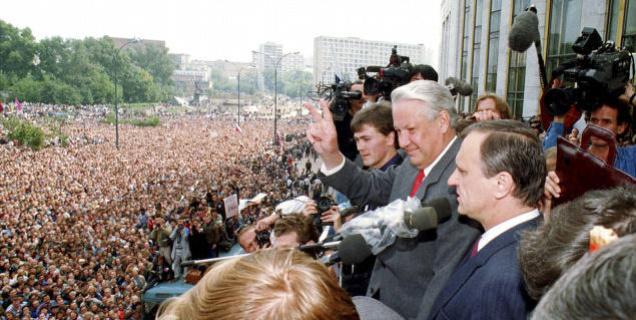
Boris Yeltsin addresses the Moscow crowd
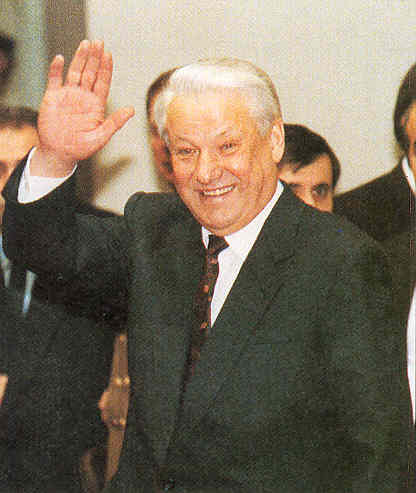
Boris Yeltsin – new Russian President

|
|
Deng's on-going reforms
Meanwhile, the new Chinese freedoms brought through Deng's reforms were having a huge impact on China as well, good and bad. The economy was booming, but then so was inflation. Criticism of the Chinese leadership was allowed (under some restrictions). The new freedoms also allowed a great deal of local political and moral corruption to develop – which the party authorities found difficult to manage. At one point, in 1983, party hardliners were able to get the Chinese Communist Party (CCP) to resume some of its former Maoist policies of tightly policing thought and action. But Deng was able to swing the party back to continuing his reforms. But political feelings at the top of the Chinese political hierarchy were still very sensitive. Then in 1986, criticism of the party by some of China's intelligentsia and university students got the hardliners stirred up again, as the youth found themselves comparing the slower speed of China's reforms with those going on in Russia, and thus complained loudly that the Chinese reforms were not moving fast enough. Tragedy at Tiananmen Square Then when in 1989 new freedoms came to East Europe, thanks to the collapse of the Soviet Empire, both the student reformers and the party hardliners found themselves in a very vigilant mood – against each other. In April thousands, then hundreds of thousands, then perhaps as many as a million students gathered in Beijing's huge Tiananmen Square to demand a similar loosening of the hold of the CCP over China. But watching the Soviet Empire collapse only stiffened the resistance of the hardliners, also opening up a division within the CCP leadership itself. The reformist CCP General Secretary Zhao Ziyang tried to hold the line for continuing reform. But even Deng began to line himself up against the growing student protest movement at the Square (similar protest gatherings were also taking place elsewhere in China at the same time). Finally on the night of June 3-4, the military was unleashed on the student gathering, and countless student deaths took place in clearing the square. The next day the student movement was to be seen no more. And soon thereafter Zhao was dismissed and put under house arrest (remaining so until his death 16 years later). The event for a while produced a distancing of the CCP from its Western friends, including America. Congress voted to cut off all further sales of military items to China, and found itself very vigilant in tracking the violation of civil rights in China. Bush also was at first highly critical of the Tiananmen tragedy, but then backed off, trying to keep a positive attitude towards China's continuing development. Jiang Zemin But the new CCP General Secretary put forward that same June by Deng, Jiang Zemin, was of the reformist branch of the party. And gradually Jiang got the reform movement back in place in China (after surviving another hardliner reaction when the Soviet Union itself dissolved in 1991). In fact, Jiang would take over Deng's position when he retired in 1992, and then acquire and hold the party's various leadership positions all the way up until 2002/2003. But even here, Chinese reform paid a huge price. In putting in Jiang's hands direction of all key state and party matters, this ended Deng's policy of checking and balancing power at the top. Once again, the party and the state had come under the command of a single individual.
|
Serious problems begin
to develop in the late spring of 1989 – as Chinese students demand
some of the same reforms that they see Communism
undergoing in Eastern Europe
Students in Tiananmen square
calling for reforms in China similar to those
undertaken in Russia by Gorbachev
– Spring of 1989
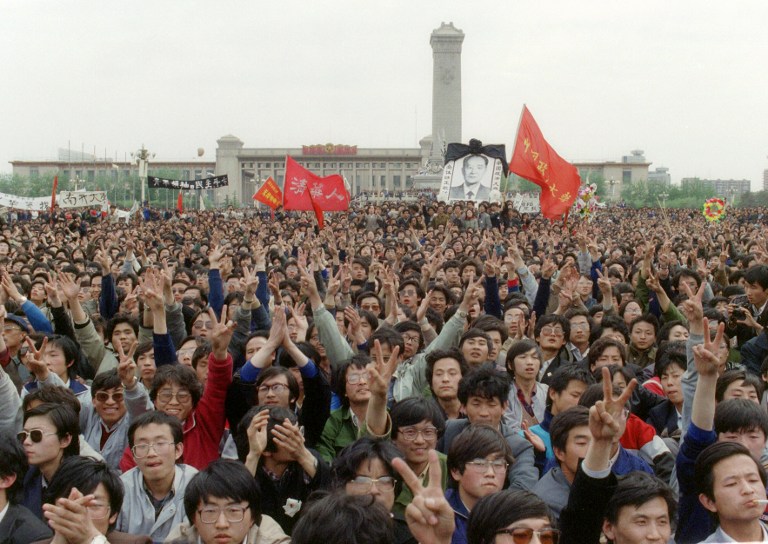
April 22, 1989 -
thousands (200,000?) of students at Tiananmen Square gather
to honor Liberal reformer
Hu Yaobang
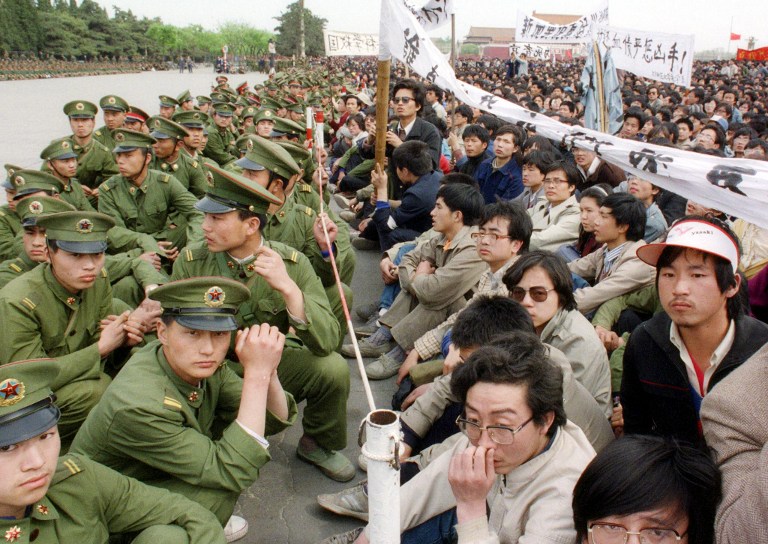
Police and protesters meet at a line drawn up in front of the Great Hall of the People
Student demonstrators gather in ever greater numbers in Tiananmen Square, Beijing – April 27, 1989
Students in Tiananmen Square
in silent protest before the Red Army – late spring 1989.
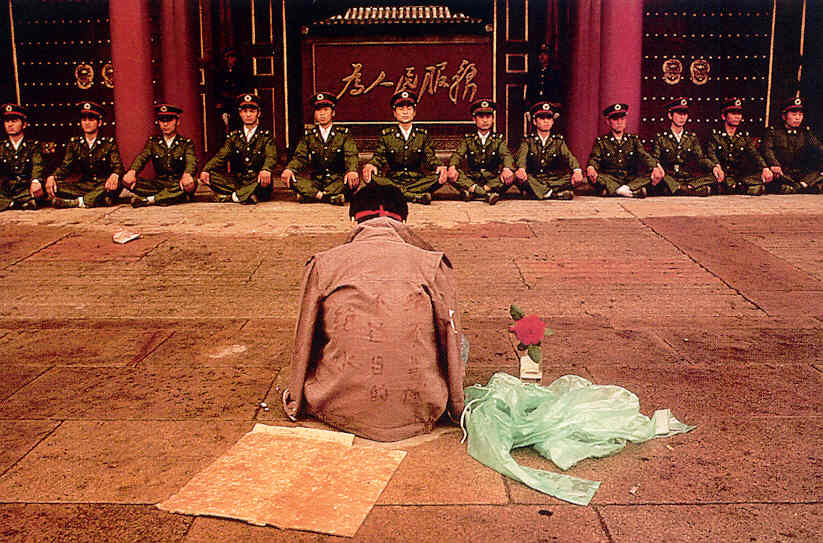
A student protester seated before the Chinese military – May 1989.
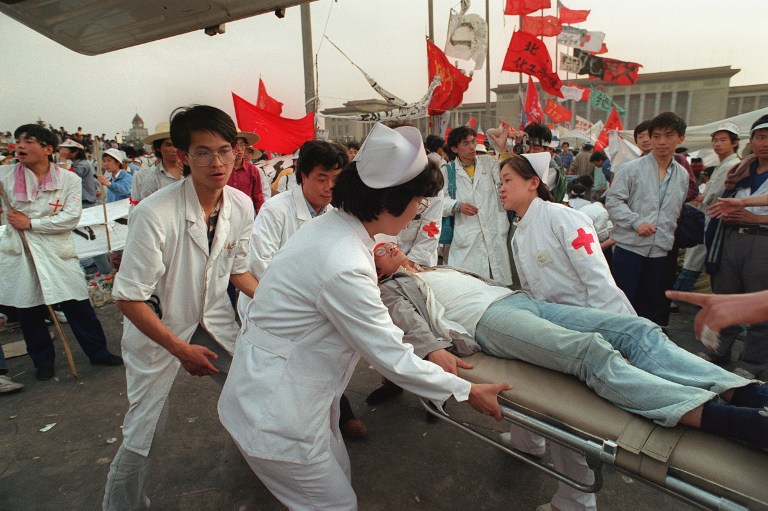
In mid-May a number of the students undertook a hunger-strike to protest in favor of democracy
By the beginning of June hundreds of thousands (even a million?) had convened on Tiananmen Square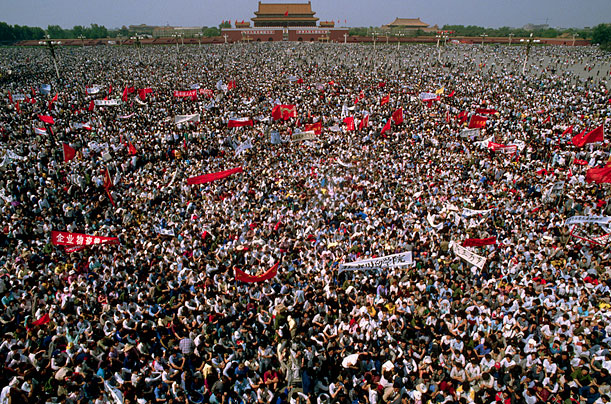
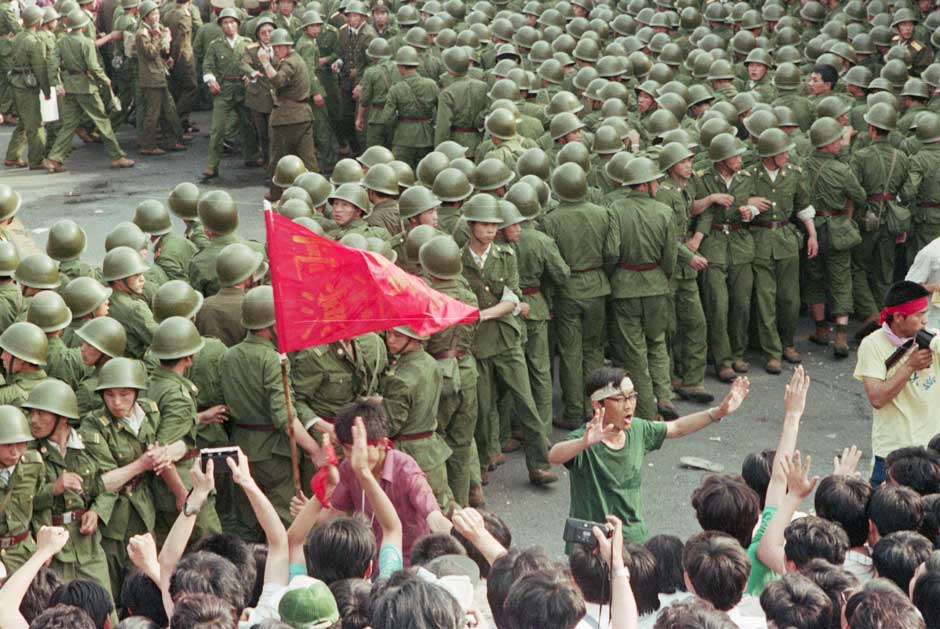
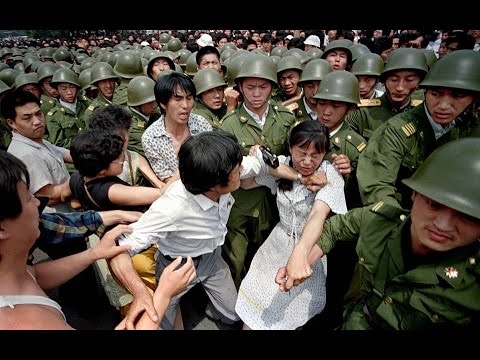
The clearing of the Tiananmen
Square by soldiers turns violent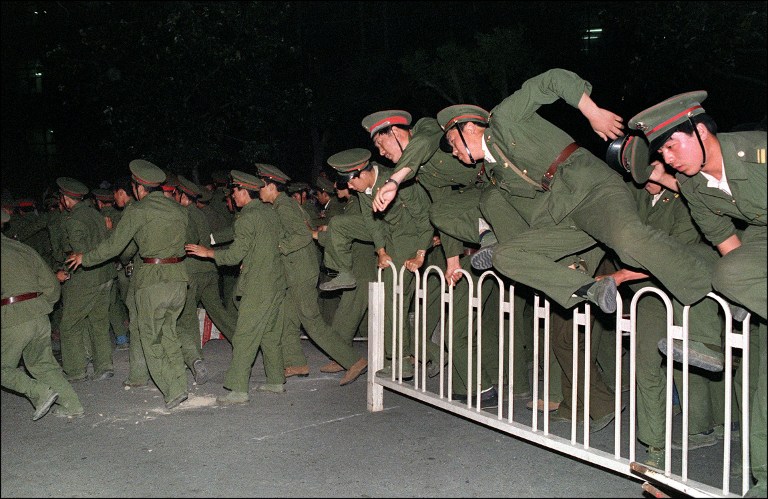
On the night of June 3-4 the soldiers begin their move to clear the
Square of protesters
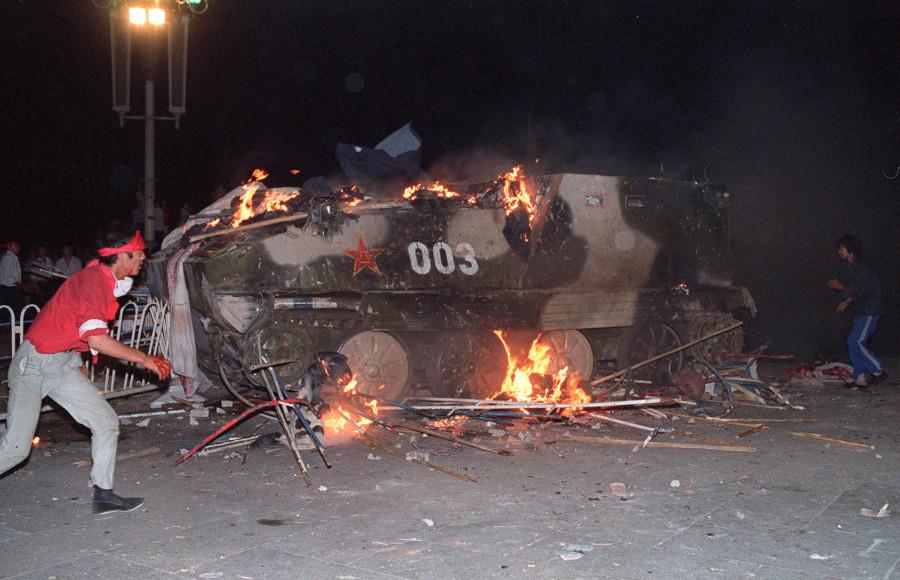
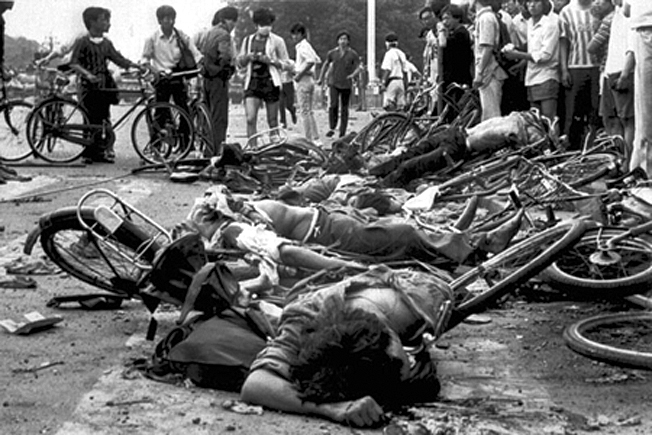
The aftermath of the Tiananmen Square
protest
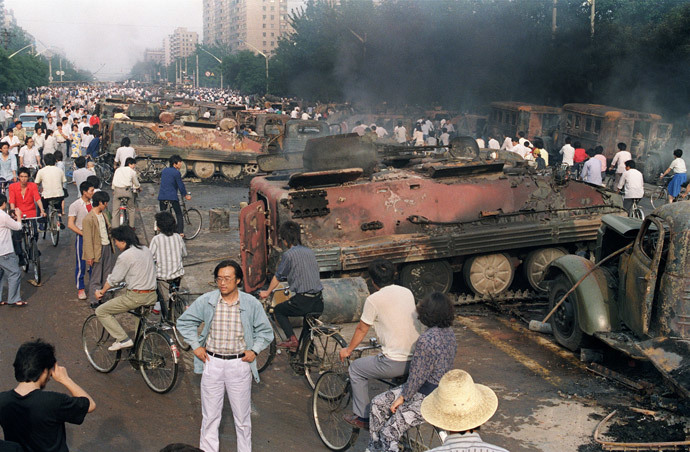
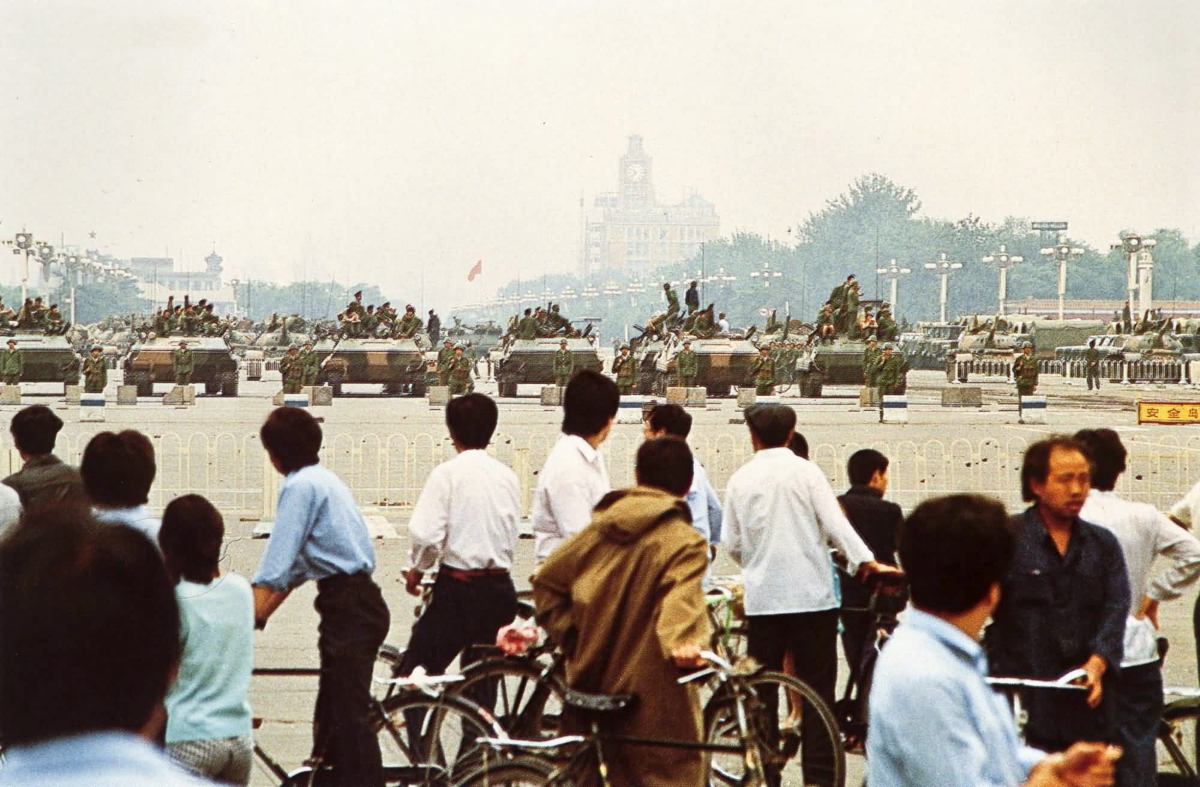
Tanks advancing on the remaining protesters
A student defying Chinese
T-59 tanks in Tiananmen Square – June 5, 1989
A lone protester and Chinese T-59 tanks at Tiananmen Square – 1989

|
|
Meanwhile, what ultimately distinguished the Bush presidency was Bush's handling of the crisis which exploded in the Persian Gulf in August of 1990 when Iraq's President Saddam Hussein ordered the surprise invasion of Iraq's tiny but oil-rich neighbor Kuwait. Quickly Saddam's huge army overran this defenseless emirate. The Arab world, and the industrial West, were both horrified. The idea of oil-rich Iraq adding oil-rich Kuwait to its holdings would put too much power over Western industry in the hands of the Iraqi dictator. It might also lead to further aggression of Iraq against a much weaker, also oil rich, Saudi Arabia next door. Bush was able to assemble a grand coalition of European and Arab armies outraged by Saddam's action, and then in early 1991 to fairly swiftly throw Saddam out of Kuwait. Not only was Kuwait liberated from this brazen aggression, but this petty dictator was treated to the worst humiliation possible before the eyes of his own people. The coalition had so much momentum going against Saddam that its troops followed Saddam in hot pursuit on into Iraq.
Many felt that it was important to finish the job and depose this petty
tyrant. But Bush realized that if he toppled Saddam's government,
America would end up having to govern Iraq, a quagmire that Bush had no
interest in getting caught up in.1 In any case this whole episode known as the "Gulf War" came to America as a great victory, and a great morale booster. Background to the War: Saddam Hussein's Iraq Saddam would survive, as he always seemed to. He even claimed his venture to be a great victory for Iraq, because his army had "paralyzed" the mighty America at the thought of invading Iraq. Or so he told his people. And the lie worked – somewhat. Saddam was not an untypical ruler in the Arab Middle East. He was a vicious tyrant who thought nothing of murdering his political opponents if they got in his way. He held together a fractious population by terrorizing into social compliance the various mutually-hostile ethnic subgroups that co-existed very uneasily as the Iraqi "nation." And he was always playing to the larger audience of fellow Arabs throughout the Middle East, in competition with others who were doing the same thing. A big part of the problem was that Iraq was not a nation. The Arabs of the entire Middle East, or at least the majority Sunni portion of the Arab world, were possibly a nation. But since the downfall of the Turkish Ottoman Empire at the end of World War One, the Arab lands had been divided by victorious English and French into a number of smaller political units that were supposed to be nations. It was at this time that Iraq came into being. Iraq was not a nation and had never been a nation. It anciently was the center of large empires at one time or another, thousands of years ago as Babylon and Assyria, and centuries ago as the heart of the world of Islam under the Abbasid dynasty. But the Iraq of the 20th century was simply a provincial "nation" cobbled together by the British at the end of World War One to allow British petroleum interests easy access to the vital oil supplies of the entire region. The British lumped together a large Arab Shi'ite population with a smaller but traditional enemy Arab Sunni population, and added to that a huge section of the Kurdish (non-Arab) society to the north. This way they put under a single command the wealth of the northern Kurdish oil fields around Mosul and Kirkuk with the southern Shi'ite Arab oil fields around Basra, and gave the whole thing over to Sunni Arab allies led by a pro-British royal family. Iraq, under the rule of the Hashemite king and family, was a precarious political entity, held together largely by British power. But with the end of World War Two and the downfall of the British Empire in 1947-1948, the Hashemite monarchy found itself on its own. In 1958 the monarchy was overthrown in a very violent coup led by Sunni officers of the Iraqi army. The purpose of the coup was to bring Iraq into the Arab secular nationalist revolution that seemed to be sweeping the Middle East in the late 1950s. Egypt's Nassar was clearly the head of this all-Arab movement, and relations with Egypt quickly became ambiguous because Iraq's leader Qasim was not interested in finding himself under Nasser. Meanwhile power struggles were going on within the upper ruling military circles of Iraq itself. Some of Qasim's Sunni officers, who termed themselves Ba'athist (meaning renaissance or rebirth) Socialists, wanted to join their Syrian Ba'athist counterparts in drawing closer to union with Nasser's secular Arab national revolution which was trying to spread itself throughout the Middle East. Meanwhile the Kurds in the north of the country were getting increasingly rebellious in their desire to join with Kurds in Iran and Turkey to form their own (non-Arab/non-Turkish) Kurdish nation. This is something which they had dearly wanted since the end of World War One, but which had been blocked by the authorities of Iraq, Iran, Turkey, and even America, which took over somewhat the function of Britain in the region after World War Two. By the early 1960s the situation in the north was deteriorating as Kurdish tribes began to fight among themselves for control of a growing Kurdish independence movement. While all this was going on, Qasim had been gradually moving Iraq into the Soviet political orbit in an attempt to get backing that would help him stay in control of a deteriorating situation in Iraq. He even renewed the claim that oil rich Kuwait rightly belonged to Iraq, attempting to stir up sentiments of Iraqi nationalism. Distressed by the growing political chaos, in early 1963 another violent military coup took place, overthrowing the Qasim government (supposedly with some British and American support). But five years later in 1968, this moderately pro-Western government was itself overthrown by Ba'athist military officers who wanted to take the country once again in a more pro-Soviet Socialist direction. Among those officers was a young Saddam Hussein. Step by step Saddam rose ruthlessly within the ruling Ba'athist circles until by 1979 he was ready to declare himself President of Iraq. The Iran-Iraq War (1980-1988) But Saddam had big troubles on his hands with the overthrow of the Shah next door in Iran and the coming to power there of an old political enemy, the Ayatollah Khomeini.2 Saddam thought he would take advantage of the chaos in Iran that at first accompanied the return to Iran of Khomeini, by invading the region of Iran next to Basra, claiming that this oil rich area (also Arab rather than Iranian in language) belonged to Iraq. But Saddam's invasion quickly bogged down into a brutal stalemate. For the next eight years Iran and Iraq (Iraq now getting small amounts of American and British support) fought on, neither side gaining any advantage over the other. During this time the Kurds became more restless, and Saddam kept them cruelly in check through the use of chemical warfare, despite its high illegality under international law. Saddam also used similar tactics against his Iranian enemies. But at the time little was said, in part because America was something of a silent partner to Iraq, hoping certainly to see the collapse of Khomeini's fundamentalist Islamic regime in Iran.
Finally in 1988 the United Nations was able to broker a peace between
the two warring parties. Over a million Iraqi and Iranian soldiers and
civilians had died in this conflict – and would continue to do so after
the war because of the after-effect of the use of chemical weapons. And
both countries were exhausted economically because during this conflict
their oil industries had largely shut down (this also had caused the
huge spike in oil prices that had plagued the industrial world in the
early 1980s). Furthermore, Iraq found itself in an impossible situation
of international indebtedness, having borrowed heavily to be able to
conduct its side of the war.
Saddam and Kuwait
Following the end of the Iran-Iraq war, tensions grew with Kuwait, which, since the mid-1980s when oil prices dropped tremendously, had been overproducing oil in order to keep up its lifestyle. But this meant that Iraq, which was hoping to recover economically through oil sales, was finding its oil revenues greatly undervalued from what Saddam had hoped they would be. Iraq also accused Kuwait of slant drilling in an attempt to reach Iraqi oil reserves. And of course there was the old argument that Kuwait was originally a part of the region long governed from Baghdad and had been set up in 1920 as an independent country only to fit the petroleum interests of England (which was in fact quite true). And there was the fact that Kuwait was cosying up to the Soviets, to strengthen its political position in the Gulf. Iraq, which by then was an American ally (the third largest recipient of American foreign aid), took its complaints to the American Ambassador, who assured Saddam that America had no interest in the boundary question between Iraq and Kuwait and wanted to stay out of the dispute. Saddam took this to mean that Iraq could solve the boundary dispute on its own without American involvement. And thus when Saddam invaded Kuwait in August of 1990 and then found itself lined up against a huge American-led anti-Iraq coalition, he was shocked, and then embittered tremendously. But now he was committed in Kuwait, and could not back down without suffering a huge loss of political face in Iraq – and the Arab world in general. Thus he refused to leave Kuwait. On January 16th (1991) a massive American aerial bombing of Iraqi forces in Kuwait took place, followed the next day by an Iraqi scud missile countering attack against the 35-nation military coalition gathering in Saudi Arabia – and also on Israel. An intensive air war thus followed. At the end of the month, the Iraqis invaded Saudi Arabia, only to be crushed by a massive air response. By the middle of February, the coalition forces were ready for a ground and air assault on the Iraqi forces in Kuwait. Very quickly the Iraqi troops were thrown into confusion, and then a fairly rapid retreat – or surrender. Before the end of the month, Iraqi forces were driven from Kuwait – but setting on fire every oil well they encountered in their retreat from Kuwait. Thankfully these were extinguished by November – but only after a total loss of one billion barrels of oil. The coalition forces followed the retreating Iraqi army into Iraq, and then halted once it was clear that Iraq could offer no more defense against the invading coalition forces. Meanwhile, Kurds living in the north of Iraq had undertaken a rebellion, in pursuit of the long-standing dream of separating from Iraq (also Turkey and Iran) to form an independent Kurdish nation. But with negotiations well underway, ones designed solely to bring the larger war against Iraq to an end, no action was taken by America and the coalition to come to the Kurds' aid. Saddam's forces thus crushed the Kurdish rebellion. Indeed, much criticism was leveled at Bush for not going all the way into Iraq and finishing off Saddam and his regime. But the answer given (more than once) was that the Americans and their allies had no interest in having a collapsed Iraq to deal with. There would be no gain for anyone in having to reconstruct such a collapsed society. The pain involved would be far greater than any ultimate social rewards. A very wise assessment! Iraq and the Middle East after the Gulf War Although America had fought at the head of a victorious coalition that included a number of Arab governments, the war itself did not leave a legacy of improved American-Arab relations. Nor did it leave Saddam humbled. It seems that things developed quite to the contrary on both counts. Saddam was certainly saddled with all sorts of international restrictions and war debts designed to hobble his rule. The war itself had led Americans to finish off the Osirak nuclear reactor, which had been damaged during the Iran-Iraq war, but also greatly crippled by an Israeli bombardment in 1981. Iraq was not going to be permitted to join the company of the world's nuclear powers. Most humiliating of all, the airspace of large parts of Iraq was off limits to Saddam's own air force – and he was forced to accept the constant snooping of U.N. weapons inspectors moving around Iraq to make sure that he was no longer producing illegal biological and chemical weapons, not to mention nuclear weapons. And Iraq was put under international quarantine, not permitted to export oil (except for small amounts allowed for the purchase of food for the Iraqi population), until it had demonstrated full cooperation with the U.N. supervisory authorities. Ultimately Saddam's Western enemies were successful in shutting down much of his business and military operations in Iraq.
But Saddam fought back with waves of repression against rebellious
Kurds and Shi'ites, forcing them to resubmit to his iron rule, and
indirectly forcing the Sunnis to draw closer to him in order to stay on
top of the Iraqi social order. His bold defiance of the
American-imposed hobbling of his government actually strengthened his
stature not only among Iraqi Sunnis but also among Sunnis in much of
the rest of the Arab world. At the same time, the American failure to
come into Iraq and follow up on presumed offers of support for the
Kurds and Shi'ites in their efforts to free themselves from Saddam's
Ba'athist tyranny only embittered the Kurds and the Shi'ites,
especially the Shi'ites. The latter drew closer and closer to their
Shi'ite Iranian neighbors, with whom they had strong religious ties,
even if ethnically they were quite different (Semitic Arab versus
Indo-European Aryan or Iranian). And perhaps most ominously, it was what started the determination of a number of Arabs to take up the religious cause of militarily-conducted jihad against the West. One of those who moved into that camp to take a leading role was Osama bin Laden. 1In a very famous interview at the American Enterprise Institute in 1994, President Bush's former Secretary of Defense Dick Cheney explained why America had not "liberated" Iraq from the dictatorial rule of Saddam Hussein, stating that the loss of American lives was not worth the benefit of taking out Saddam – and that Iraq would merely become a "quagmire" for America if it were to invade. It is ironic how such wisdom seemed to be lacking when the same Cheney less than ten years later was serving as American Vice President and younger President Bush's main political advisor, now supporting Bush Jr. in doing exactly what Bush Sr. earlier understood would plunge America into a costly and pointless Iraqi quagmire. But so goes the world of politics! 2Khomeini
had come to Iraq when thrown out of Iran by the Shah; but soon he was
agitating the Iraqi Shi'ites to rise up against Saddam and his
Ba'athists and institute a Shi'ite government in Iraq; this then led
Saddam to send Khomeini packing and heading on to Paris.
|
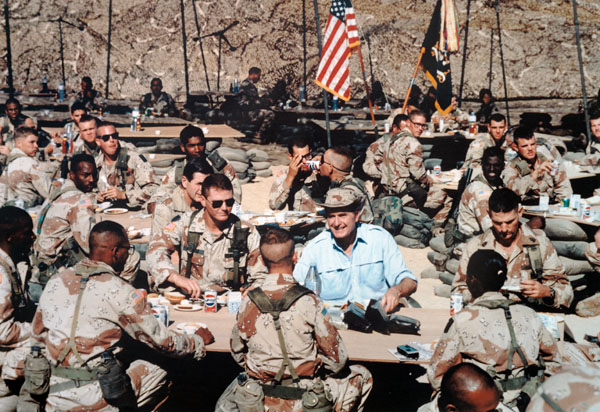
President George Bush enjoys
Thanksgiving Dinner with U. S. troops stationed in the Persian Gulf
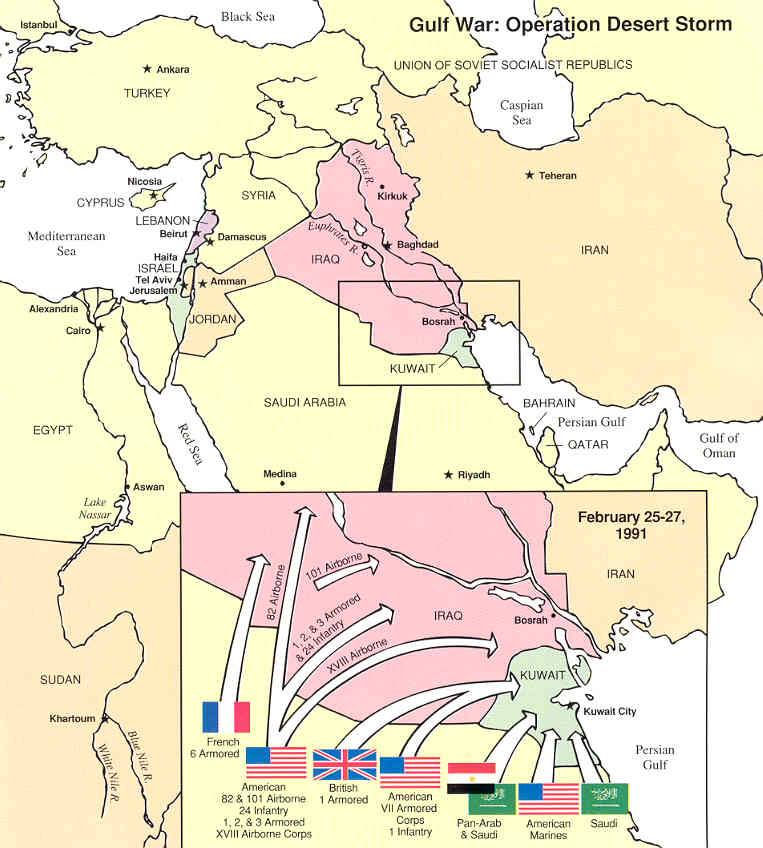
Keesee and Sidwell, p. 633
Gulf War – Air raid over
Baghdad January, 1991.
Refueling an F-117 bomber
over Iraq.
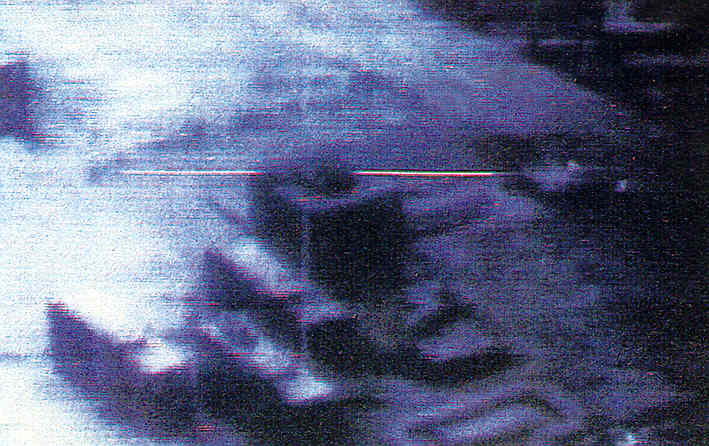
Infrared image of a Iraqi
telecommunications building
about to be blown up by a Stealth-fired intelligent
rocket
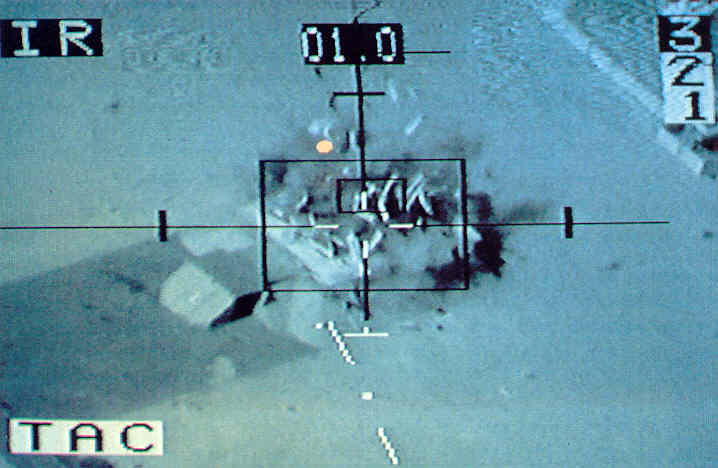
Sighted missile targeting
Iraq – 1991
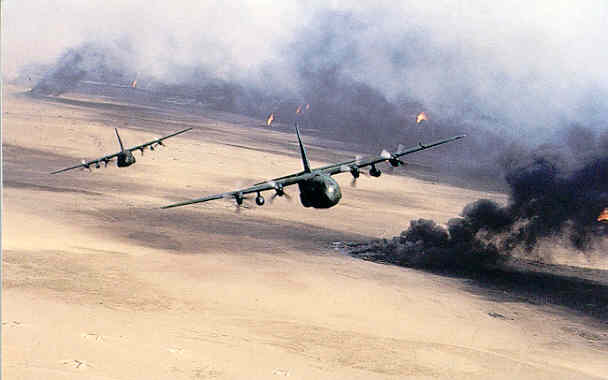
A US bomber attack on the
Iraqi positions.
US tank assault on Iraqi
lines – February 1991.
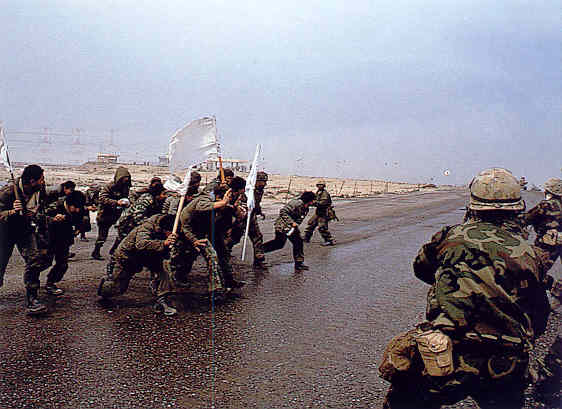
Iraqi troops
surrendering.
US Marines taking Iraqi
prisoners.
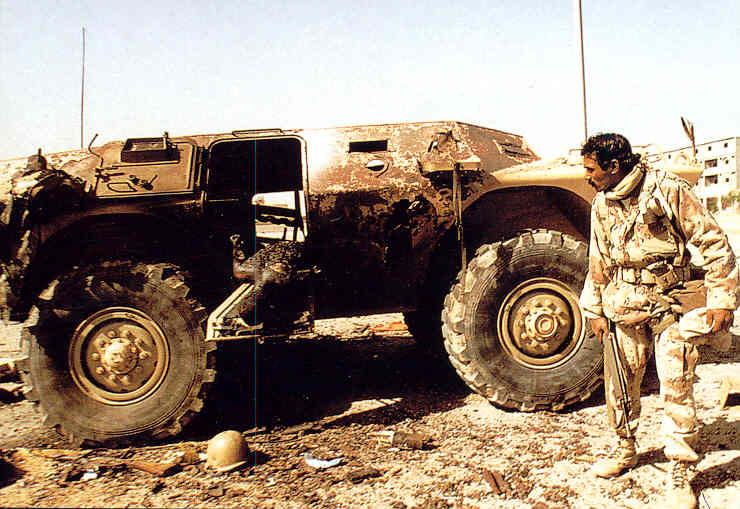
A Saudi soldier inspects
a burned-out Iraqi armored vehicle and dead Iraqi solder
America's allied Arab troops
celebrating victory
February 1991 – Gulf War
or "Desert Storm." Burning oil well silhouetted by a destroyed Iraqi
tank.
Wreckage and burning oil
fields in Kuwait in the wake of a rapidly retreating Iraqi army
US soldiers and Kuwaiti oil
fields set ablaze by retreating Iraqis – 1991
The Gulf War in Kuwait -
March 2, 1991
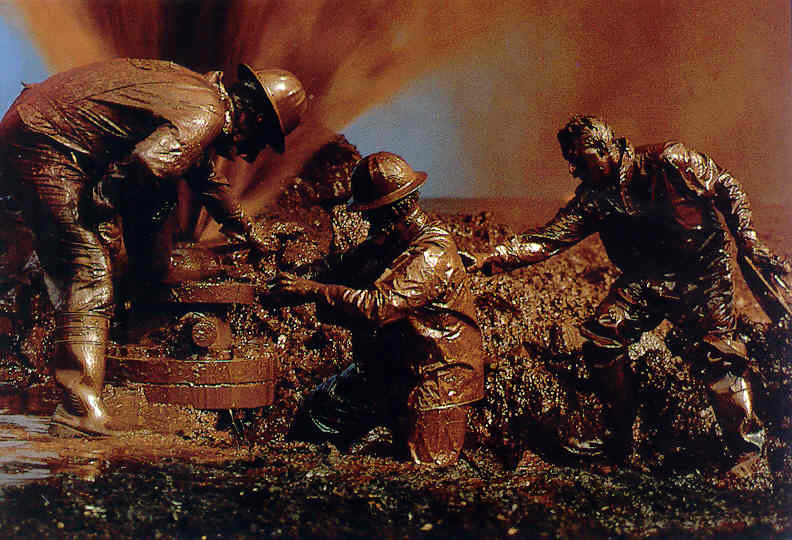
Red Adair's team putting out the Kuwaiti oil well fires started by the retreating Iraqis – 1991
|
Saddam Hussein is put under international restriction because of the cruel way (employing chemical and biological weapons) he put down the rebellions of the Arab Shi'ite and (non-Arab) Kurdish communities in Iraq ... which have long resented tremendously the domination of Iraq by the Sunni Arab community and its political arm, Saddam Hussein's Ba'athist Party. |
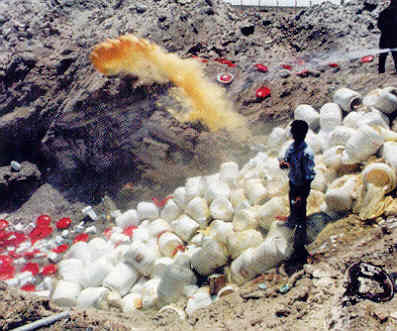
United Nations inspectors destroying suspected Iraqi bioweapons – 1996


 Miles
H. Hodges
Miles
H. Hodges